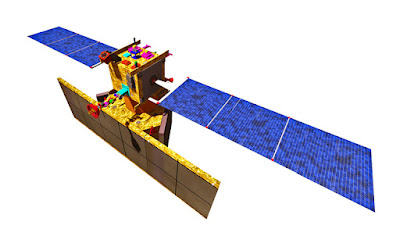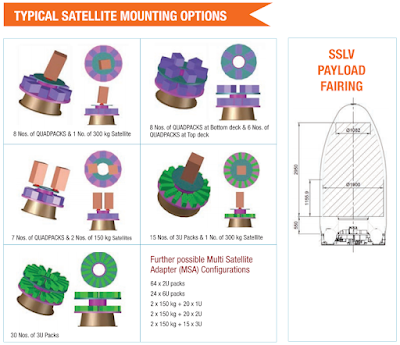Watch the PSLV-C52/EOS-04 Launch Live Streaming. (Scheduled On: February 14, 2022, at 05:30 IST)
PSLV-C 52 Launch Updates:
ISRO's first launch of 2022, under the leadership of new Chairman S. Somanath, went off without a hitch, precisely positioning all three satellites in their assigned orbits.
The PSLV C-52 of the Indian Space Research Organization lighted up the pre-dawn black sky and Pulicat Lake with thick orange fumes as it rose into the air, breaking the early stillness with the booming roar of the launch vehicle that had three satellites on board.
ISRO's first launch of 2022, under the leadership of new Chairman S. Somanath, went off without a hitch, precisely positioning all three satellites in their assigned orbits.
At 0617 IST, PSLV-C52 inserted EOS-04 into a 529km altitude sun-synchronous polar orbit, according to the Indian Space Research Organization.
The PSLV C-52 was the PSLV's 54th flight and the 23rd mission to use the PSLV-XL variant.
PSLV-C52 launched three satellites from the first launch pad at Satish Dhawan Space Centre in Sriharikota at 5.59 a.m on Monday, including its principal payload, the EOS-04 radar imaging satellite.
- The EOS-04 satellite was put in a solar synchronous orbit 17 minutes after launch.
- The rocket then inserted the two additional satellites, INS-2TD and Inspiresat-1, a minute later.
- The fourth stage was passivated to remove residual propellants four minutes after lift-off, using mixed oxides of nitrogen (MON) passivation followed by mono methyl hydrazine (MMH) passivation, two propellants that power PSLV's upper stage.
- The passivation process lasted ten minutes.
- Passivation is the process of removing any remaining fuel from a rocket to avoid the higher stages from exploding.
- The top stage burns inactively or vents the leftover propellants.
PSLV's 54th flight and 23rd mission with six PSOM-XLs used the PSLV-XL configuration.
"The main satellite, EOS-04, has been placed in a very exact orbit by PSLV-C52," Isro chairman S Somanath stated, congratulating the crew.
The INS-2TD and INSPIREsat-1 co-passenger satellites have also been put in the proper orbits.
This spacecraft will be one of the most valuable assets in the country's arsenal.
We will come back with another PSLV launch very soon."
"First and foremost, let me congratulate the PSLV crew for the exact inject of EOS-04," Srikanth remarked.
The launch has re-energized the ISRO crew.
The most awaited spacecraft, EOS-04, is an earth observation mission that will serve the country in agriculture, soil moisture, disaster management, disaster assessment, carbon inventory, forest and plantation management, and many other sectors with indigenously developed state-of-the-art technology SAR."
"After separation, EOS-04's health is in fantastic condition.
I'm pleased to report that the solar panels have been deployed autonomously and have begun to provide the desired electricity....
The satellite will be ready to offer the first sight of photos in a few days following calibration and outgassing.
Many government services will be enhanced by the services.
EOS-04 is a minor step toward the country's objective of opening the space sector with industry engagement in the form of build to print, as well as assemble and test.
We were able to achieve a reasonable level of success in our endeavor."
The launch's success was critical for ISRO, who had a quiet 2020 with just two launches, one of which, the GSLVF10, crashed shortly after launch.
On Monday, the PSLV C-52, carrying the Earth Observation Satellite EOS 04, the INS-2TD, an ISRO technology demonstrator, and the INSPIREsat-1, a student satellite, launched from the Satish Dhawan Space Centre, SHAR, Sriharikota, at 5.59 a.m.
The three satellites were separated and sent into their orbits 18 minutes later.
"The EOS 04, the principal spacecraft, has been placed in a precise orbit.
The co-passenger satellites have been positioned in the proper orbit," Mr. Somanath said, adding that ISRO would "be back with the next PSLV launch very shortly."
- The EOS-4, a radar imaging satellite with a 10-year mission life, is intended to deliver high-quality pictures in all weather circumstances for agricultural, forestry, plantation, flood mapping, soil moisture, and hydrological applications.
- According to ISRO, the satellite would acquire earth observation data in the C-band, complementing and supplementing data from the Resourcesat, Cartosat, and RISAT-2B series.
- The INS-2TD will measure land and water surface temperatures, agricultural and forest delineation, and thermal inertia as a forerunner to the India-Bhutan joint satellite [INS 2-B].
- INSPIREsat-1 is a student satellite developed by the Indian Institute of Space Science and Technology in collaboration with the University of Colorado in the United States.
- Its goal is to improve knowledge of ionosphere dynamics and coronal heating processes on the Sun.
On Monday, Prime Minister Narendra Modi congratulated India's space experts on the success of the PSLV C52 mission launch.
"Congratulations to our space experts on the successful launch of PSLV C52 mission," Mr. Modi tweeted.
About The EOS-04 Earth Observation Satellite:
EOS-04 is a Radar Imaging Satellite that is intended to deliver high-quality photos in all weather circumstances for applications including agriculture, forestry, and plantations, soil moisture and hydrology, and flood mapping.
The tentative launch time of the Polar Satellite Launch Vehicle, PSLV-C52, is planned for February 14, 2022, at 05:59 a.m from the Satish Dhawan Space Centre's First Launch Pad at Sriharikota.
The Indian Space Research Organisation (ISRO) will launch PSLV-C52, an earth observation satellite, into orbit on February 14 at 5.59 a.m., with the countdown beginning on Sunday morning. This is the ISRO's first launch mission of the year.
PSLV-C52 is planned to place the 1710 kg EOS-04 into a 529 km sun-synchronous polar orbit, according to ISRO.
PSLV-C52 Mission Summary:
1. The PSLV-C52 will be launched from Sriharikota's Satish Dhawan Space Centre's First Launch Pad.
2. According to the space agency, EOS-04 is a Radar Imaging Satellite intended to deliver high-quality photos in all weather circumstances for applications such as agriculture, forestry and plantations, soil moisture and hydrology, and flood mapping.
3. The mission will also carry two small satellites as co-passengers:
- An Indian Institute of Space Science and Technology student satellite (INSPIREsat-1) in collaboration with the University of Colorado Boulder's Laboratory of Atmospheric and Space Physics,
- And an ISRO technology demonstrator satellite, INS-2TD.
PSLV-C52 will also carry an ISRO technology demonstration satellite (INS-2TD), which is a forerunner to the India-Bhutan Joint Satellite Program (INS-2B).
- The 17.5-kilogram satellite will only be operational for six months.
The launch comes months after the disastrous loss of the Earth Observation Satellite (EOS-03) in August of last year, which was unable to be deployed owing to a "technical problem."
- A thermal imaging sensor on board the satellite will aid in the evaluation of land, water surface temperatures, vegetation delineation, and thermal inertia.
The final payload is an 8.1-kilogram student satellite called INSPIRESat-1, which was designed by the Indian Institute of Space Science & Technology in collaboration with the University of Colorado's Laboratory of Atmospheric & Space Physics.
- The satellite will help us better understand the dynamics of the ionosphere and the sun's coronal heating process.
- It has a one-year operating lifespan.
PSLV C-52 - The 54th Polar Satellite Launch Vehicle Launch
The PSLV's 54th mission will see it ascend to a Sun Synchronous Orbit height of 529 kilometers above the Earth's surface, where it will deploy the Earth Observation Satellite.
- The PSLV is an Indian-designed third-generation launch vehicle that can carry up to 1,750 kg of cargo to 600 km altitude Sun-Synchronous Polar Orbits.
- In 2008, the four-stage rocket successfully launched Chandrayaan-1 to the Moon, and in 2013, the Mars Orbiter Spacecraft to Mars.
- The liftoff mass of the 44-meter-tall vehicle is 320 tons.
Stages Of The PSLV-C52:
- PSLV's first stage is powered by the S139 solid rocket motor, which is supplemented by six solid strap-on boosters,
- While the second stage is powered by the Vikas engine, which was developed in India.
- The PSLV's third stage is a solid rocket motor that gives high thrust to the higher stages following the launch's atmospheric phase, while the fourth stage is made up of two Earth-storable liquid engines.
ISRO's Upcoming Missions
In the next three months, ISRO plans to launch five significant satellites in order to reclaim its lost ground in space operations, despite stiff competition from China and commercial companies such as SpaceX, which plans to launch one satellite per week in 2022.
- ISRO will launch OCEANSAT-3 and INS 2B ANAND on PSLV C-53 in March and SSLV-D1 Micro SAT in April 2022, after the PSLV-C52 mission.
- ISRO will also launch GSAT-21, New Space India Limited's first fully sponsored satellite (NSIL).
- The space agency, which recently appointed renowned rocket scientist S Somnath as its new leader, has 19 missions slated for flight in 2022.
- Eight launch vehicle flights, seven spacecraft missions, and four technology demonstration missions are among them.
In August, the agency will launch its ambitious Chandrayaan-3 mission to the Moon, aiming for Gaganyaan's first uncrewed trip, the country's first astronaut mission.
You may also want to read more about space based systems here.



























































